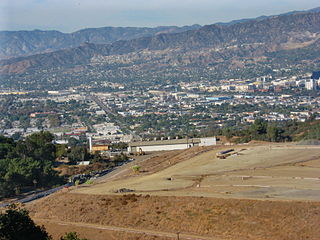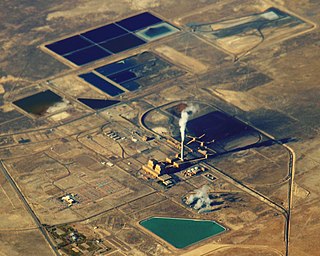
Electricity generation is the process of generating electric power from sources of primary energy. For utilities in the electric power industry, it is the stage prior to its delivery to end users or its storage, using for example, the pumped-storage method.

A power station, also referred to as a power plant and sometimes generating station or generating plant, is an industrial facility for the generation of electric power. Power stations are generally connected to an electrical grid.
The Los Angeles Department of Water and Power (LADWP) is the largest municipal utility in the United States with 8,100 megawatts of electric generating capacity (2021–2022) and delivering an average of 435 million gallons of water per day to more than four million residents and local businesses in the City of Los Angeles and several adjacent cities and communities in southwestern Los Angeles County, California.

A fossil fuel power station is a thermal power station which burns a fossil fuel, such as coal or natural gas, to produce electricity. Fossil fuel power stations have machinery to convert the heat energy of combustion into mechanical energy, which then operates an electrical generator. The prime mover may be a steam turbine, a gas turbine or, in small plants, a reciprocating gas engine. All plants use the energy extracted from the expansion of a hot gas, either steam or combustion gases. Although different energy conversion methods exist, all thermal power station conversion methods have their efficiency limited by the Carnot efficiency and therefore produce waste heat.

The Moss Landing Power Plant is a natural gas powered electricity generation plant located in Moss Landing, California, United States, at the midpoint of Monterey Bay. Its large stacks are landmarks, visible throughout the Monterey Bay Area. The plant is owned and operated by Houston-based Dynegy and currently has a generation capacity of 1020 MW (net) from its two combined cycle generation units. It was once the largest power plant in the state of California, with a generation capacity of 2560 MW, before its two large supercritical steam units were retired in 2016.
Hydrogen gas is produced by several industrial methods. In 2022 less than 1% of hydrogen production was low-carbon. Fossil fuels are the dominant source of hydrogen, for example by steam reforming of natural gas. Other methods of hydrogen production include biomass gasification and methane pyrolysis. Methane pyrolysis and water electrolysis can use any source of electricity including renewable energy. Underground hydrogen is extracted.

The Toyon Canyon Landfill is located within Griffith Park in the Los Feliz hillside neighborhood of greater Hollywood in central Los Angeles, California in the Santa Monica Mountains. The landfill began filling in 1957 and ended in 1985. A lawsuit in 1959 attempted to stop the project but was unsuccessful. There was a move in the 1980s to expand the landfill into Royce's Canyon to the northwest, but that was defeated.

Peterhead Power Station is a multi-unit station owned and operated by SSE plc, with a capacity of 2,177 MW. It is located near Boddam and the A90, just south of Peterhead, in Aberdeenshire, in the northeast of Scotland. It stands next to Sandford Lodge, a circa-1800-built structure. Initially operating as an oil-fired power station and later transitioning to fossil gas, the plant has also served as a site for experimental hydrogen generation capacity.

A gas-fired power plant, sometimes referred to as gas-fired power station, natural gas power plant, or methane gas power plant, is a thermal power station that burns natural gas to generate electricity. Gas-fired power plants generate almost a quarter of world electricity and are significant sources of greenhouse gas emissions. However, they can provide seasonal, dispatchable energy generation to compensate for variable renewable energy deficits, where hydropower or interconnectors are not available. In the early 2020s batteries became competitive with gas peaker plants.

Grain Power Station is a 1,275 megawatts (1,710,000 hp) operational CCGT power station in Kent, England, owned by Uniper. It was also the name of an oil-fired, now demolished, 1,320MW power station in operation from 1979 to 2012.

The Chalk Point Generating Station is an electricity-generating plant, comprising oil and natural gas fired units, owned by NRG Energy, located near the town of Eagle Harbor, Maryland, United States, on the Patuxent River.

Mohave Power Station was a 1580 megawatt electric (MWe) coal-fired power plant that was located in Laughlin, Nevada. Southern California Edison is the majority owner of the plant and was its operator. The plant entered commercial operation in 1971. A steam line that ran near the plant's control room and cafeteria ruptured on June 9, 1985, fatally scalding six and injuring ten more. In 2005, the plant was shut down and was later dismantled.

Landfill gas utilization is a process of gathering, processing, and treating the methane or another gas emitted from decomposing garbage to produce electricity, heat, fuels, and various chemical compounds. After fossil fuel and agriculture, landfill gas is the third largest human generated source of methane. Compared to CO2, methane is 25 times more potent as a greenhouse gas. It is important not only to control its emission but, where conditions allow, use it to generate energy, thus offsetting the contribution of two major sources of greenhouse gases towards climate change. The number of landfill gas projects, which convert the gas into power, went from 399 in 2005 to 519 in 2009 in the United States, according to the US Environmental Protection Agency. These projects are popular because they control energy costs and reduce greenhouse gas emissions. These projects collect the methane gas and treat it, so it can be used for electricity or upgraded to pipeline-grade gas. These projects power homes, buildings, and vehicles.

Intermountain Power Plant is a large coal-fired power plant at Delta, Utah, US. It has an installed capacity of 1,900 MW, is owned by the Intermountain Power Agency, and is operated by the Los Angeles Department of Water and Power. The plant includes a HVDC converter. It is scheduled in 2025 for replacement with an 840 MW natural gas plant, designed to also burn "green hydrogen."

Nury Martinez is an American politician who served as a member of the Los Angeles City Council for the 6th district from 2013 until her resignation in 2022. A former member of the Democratic Party, Martinez became president of the Los Angeles City Council in December 2019, after serving as the council's president pro tempore. Martinez was the first Latina to become council president. She was a member of the Los Angeles Unified School District Board of Education from 2009 to 2013.

The Aliso Canyon gas leak was a massive methane leak in the Santa Susana Mountains near the neighborhood of Porter Ranch in the city of Los Angeles, California. Discovered on October 23, 2015, gas was escaping from a well within the Aliso Canyon underground storage facility. This second-largest gas storage facility of its kind in the United States belongs to the Southern California Gas Company, a subsidiary of Sempra Energy. On January 6, 2016, Governor Jerry Brown issued a state of emergency. On February 11, the gas company reported that it had the leak under control. On February 18, state officials announced that the leak was permanently plugged.

Gateway Generating Station (GGS), formerly Contra Costa Unit 8 Power Project, is a combined-cycle, natural-gas-fired power station in Contra Costa County, California, which provides power to half a million customers in northern and central California. Gateway Generating Station is on the southern shore of the San Joaquin River, in Antioch, and is one of more than ten fossil-fuel power plants in Contra Costa County.
Trafford power station supplied electricity to the Trafford and Stretford areas of Greater Manchester, and to the national grid, from 1929 to 1976. The generating station was built by the Stretford and District Electricity Board which it operated until the nationalisation of the British electricity supply industry in 1948. The 60 megawatt coal-fired station was supplemented in 1952 with an experimental 15 megawatt gas turbine generating set.

Scattergood Generating Station is an electricity-generating facility in the Playa Del Rey area of Los Angeles, California, in proximity to El Segundo and LAX. Scattergood has an 830 MW capacity spread across three steam turbine units. Owned and operated by the Los Angeles Department of Water and Power (LADWP), the station is a coastal landmark of the Santa Monica Bay in southern California. Plans are in place to convert the station to hydrogen power.

















